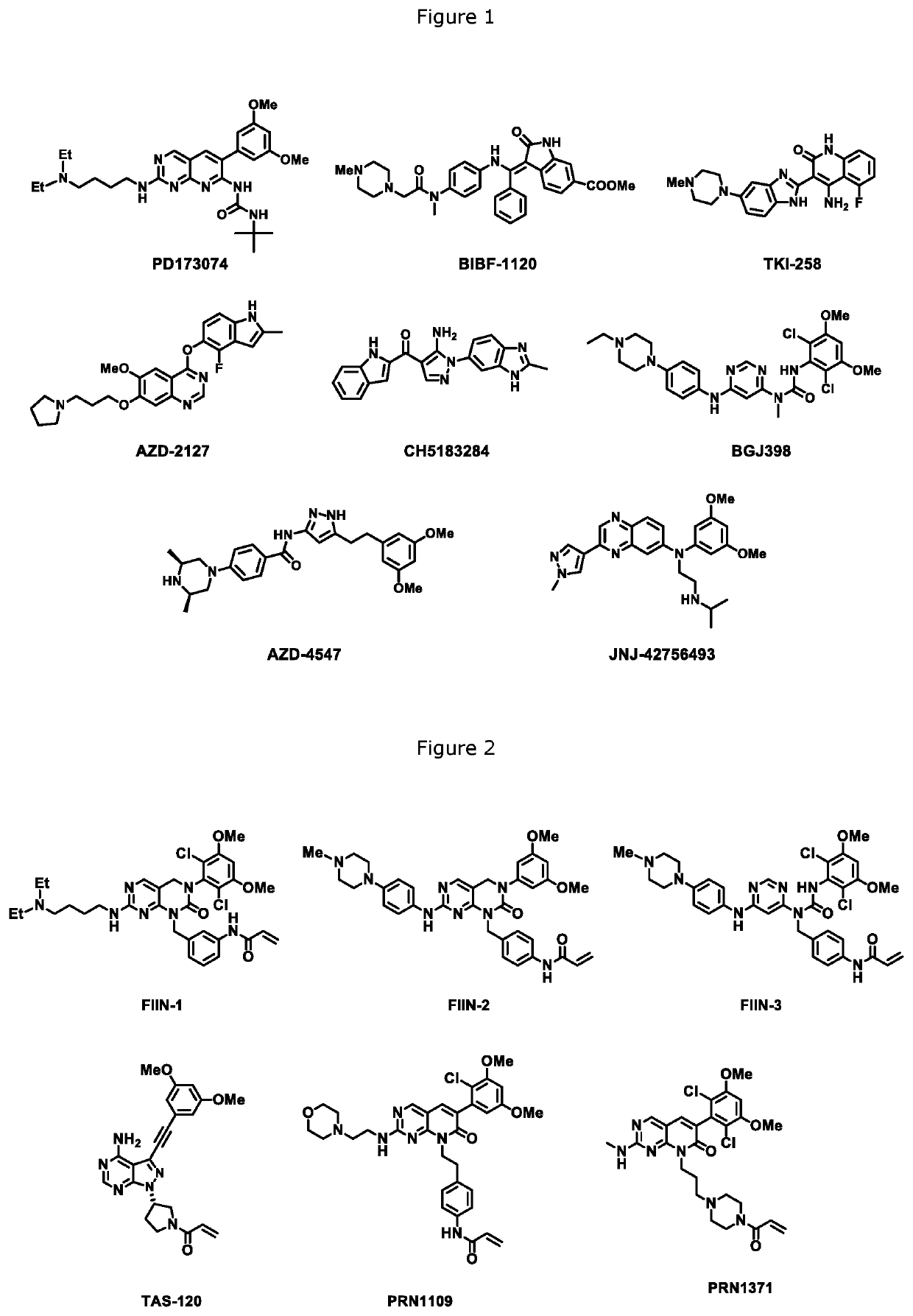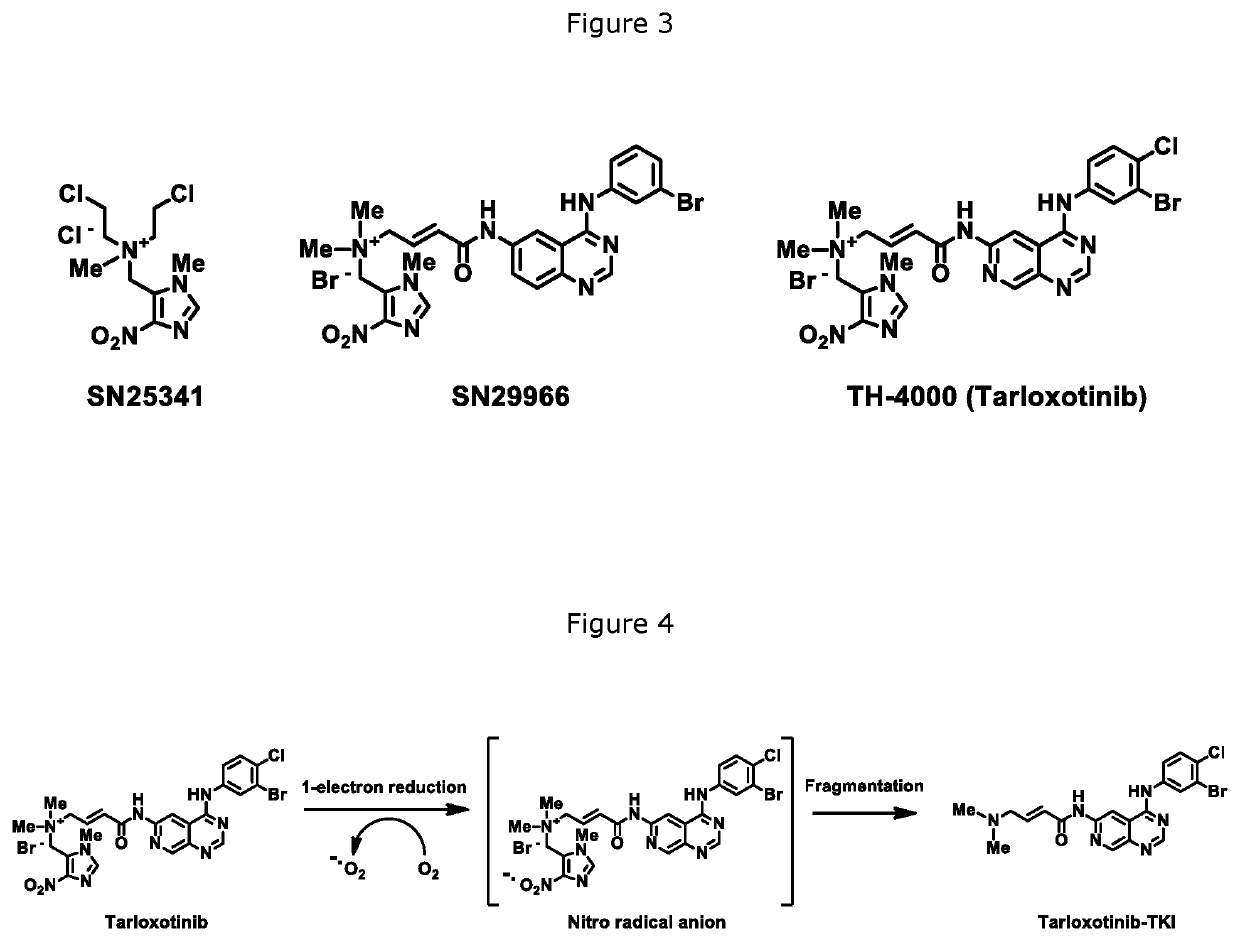FGFR kinase inhibitors and pharmaceutical uses
a technology of fibroblast growth factor receptor and kinase inhibitor, which is applied in the direction of drug composition, organic chemistry, organic active ingredients, etc., can solve the problems of poor therapeutic ‘window’ to silence, treatment breaks are expected to be detrimental to inhibiting the growth of fgfr-dependent cancers
- Summary
- Abstract
- Description
- Claims
- Application Information
AI Technical Summary
Problems solved by technology
Method used
Image
Examples
example 1
6-dichloro-3,5-dimethoxyphenyl)-1-(1-(4-(dimethylamino)-but-2-enoyl)piperidin-4-yl)-7-(isopropylamino)-3,4-dihydropyrimido[4,5-d]pyrimidin-2(1H)-one (108)
[0371]A synthetic route for the preparation of compound 108 is outlined in Scheme 7.
[0372]
Ethyl 4-((1-(tert-butoxycarbonyl)piperidin-4-yl)amino)-2-(methylthio)-pyrimidine-5-carboxylate (301)
[0373]To a solution of ethyl 4-chloro-2-(methylthio)pyrimidine-5-carboxylate (300) (21 g, 90.3 mmol) and tert-butyl 4-aminopiperidine-1-carboxylate (21.7 g, 108.3 mmol) in DMF (300 mL) was added K2CO3 (25 g, 180.9 mmol). The reaction was heated to 60° C. overnight. After the mixture was cooled to room temperature, it was added to ice-water. The precipitate was filtered, and the filtered cake was washed with cool water and dried in a vacuum oven to afford 301 (31.1 g, 86.9%). 1H NMR (400 MHz, CDCl3) δ 8.63 (s, 1H), 8.50 (d, J=7.2 Hz, 1H), 4.31 (q, J=7.2 Hz, 2H), 4.27-4.21 (m, 1H), 4.00-3.97 (m, 2H), 3.02 (t, J=11.4 Hz, 2H), 2.51 (s, 3H), 2.03-1.9...
example 2
6-dichloro-3,5-dimethoxyphenyl)-1-(1-(4-(dimethyl-amino)-but-2-enoyl)piperidin-4-yl)-7-(phenylamino)-3,4-dihydropyrimido[4,5-d]pyrimidin-2(1H)-one (112)
[0381]A synthetic route for the preparation of compound 112 is outlined in Scheme 7 (see Example 1).
3-(2,6-dichloro-3,5-dimethoxyphenyl)-7-(phenylamino)-1-(piperidin-4-yl)-3,4-dihydropyrimido[4,5-d]pyrimidin-2(1H)-one (309)
[0382]Aniline (0.3 ml, 2.92 mmol) was added to a solution of 307 (0.9 g, 1.46 mmol) in 1,4-dioxane (10 mL), followed by adding TFA (0.12 ml, 1.61 mmol). The reaction mixture was stirred at 110° C. for 18 hours in a sealed tube. The mixture was cooled to room temperature and concentrated in vacuo. The crude product was dissolved in CH2Cl2 (10 mL), then TFA (1.0 mL) was added. The resulting mixture was stirred at room temperature for 4 h. The mixture was basified with saturated aqueous NaHCO3. The organic layer was separated, washed with brine and concentrated in vacuo. The resultant crude material was purified by co...
example 3
2,6-dichloro-3,5-dimethoxyphenyl)-1-(1-(4-(dimethylamino)-but-2-enoyl) piperidin-3-yl)-7-(methylamino)-3,4-dihydropyrimido[4,5-d]pyrimidin-2(1H)-one (100)
[0384]Compound 100 was prepared according to the general method of Scheme 1.
[0385][α]D20 5.405 (c 0.37, CH2Cl2). 1H NMR (500 MHz, DMSO-d6) δ 8.00 (s, 1H), 7.09 (s, 1H), 6.98 (s, 1H), 6.74-6.46 (m, 2H), 4.77-4.24 (m, 4.5H), 4.23-4.00 (m, 1.5H), 3.95 (s, 6H), 3.14-2.91 (m, 3H), 2.96-2.72 (m, 3H), 2.64 (s, 1H), 2.14 (d, J=16.6 Hz, 6H), 1.79 (d, J=13.3 Hz, 2H), 1.41 (d, J=12.5 Hz, 1H). 13C NMR (125 MHz, DMSO-d6) δ 164.09, 161.79, 156.50, 154.67, 151.25, 141.53, 137.87, 122.63, 113.17, 99.46, 98.18, 59.79, 56.85, 55.97, 54.83, 44.88, 44.81, 39.09, 39.02, 27.85, 18.49. HRMS (ESI) for C26H33Cl2N7O4 [M+H]+ calcd: 578.2044, found: 578.2038. HPLC analysis: MeOH—H2O (90:10) 5.28 min, 95.92% purity.
PUM
| Property | Measurement | Unit |
|---|---|---|
| median survival time | aaaaa | aaaaa |
| median survival time | aaaaa | aaaaa |
| median survival time | aaaaa | aaaaa |
Abstract
Description
Claims
Application Information
 Login to View More
Login to View More - R&D
- Intellectual Property
- Life Sciences
- Materials
- Tech Scout
- Unparalleled Data Quality
- Higher Quality Content
- 60% Fewer Hallucinations
Browse by: Latest US Patents, China's latest patents, Technical Efficacy Thesaurus, Application Domain, Technology Topic, Popular Technical Reports.
© 2025 PatSnap. All rights reserved.Legal|Privacy policy|Modern Slavery Act Transparency Statement|Sitemap|About US| Contact US: help@patsnap.com



